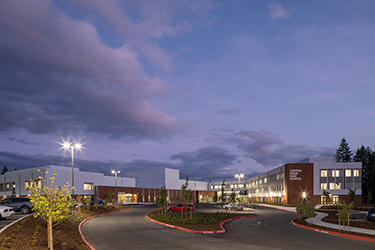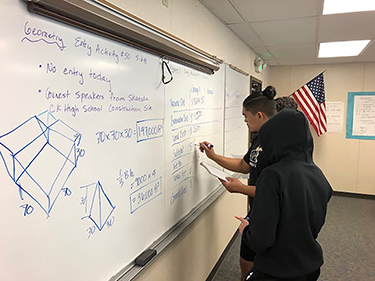|
Subscribe / Renew |
|
|
Contact Us |
|
| ► Subscribe to our Free Weekly Newsletter | |
| home | Welcome, sign in or click here to subscribe. | login |
Construction
| |
 |
September 30, 2021
Providing for diversity in K-12 schools
Skanska USA Building

Urban
|
In the construction industry, we often talk about how the schools we’re building today are designed for the students of tomorrow. We talk about how these massive, complex facilities must function in ways where education is paramount, and how project teams must focus intently on providing high-performing learning environments.
We also talk about how these schools are often the hub of their respective communities and the place where students’ career dreams for the future are first formulated. That’s why, when it comes to K-12 education projects that Skanska is involved with, we also take an interest in how we can contribute to the community and depth of education taking place in the existing schools while we’re on the jobsite (often next door) building the new ones.
Whether it’s in elementary, middle or high school, today’s student population is more diverse than ever before, and in more ways than ever before. Beyond the obvious, this diversity includes a wide range of socioeconomic backgrounds that afford students within the same school an assortment of life experiences and opportunities that may shape who they are and how they view the world.
Like each of us who came before them, today’s students have their own interests, passions and ambitions both outside the classroom and within. Recognizing, celebrating and helping encourage those curiosities and aspirations is something we strongly support, to the delight of our education clients.
When working with school districts and administrators, we hear how great it would be if we were able to help show students the wide range of careers available in our industry, as many students have no idea the breadth of roles available. Many assume that the construction industry is populated primarily by folks who excelled in the industrial arts (aka “the shop class kids”).
They have no idea that today companies like Skanska employ civil engineers, geologists, environmental engineers, hydrologists, BIM (building information modeling) technicians, environmental health and safety officers, estimators, quality control professionals, superintendents, project managers, financial managers, marketers, human resources professionals, labor relations specialists, training directors, apprenticeship coordinators, and, yes, tradespeople — carpenters, plumbers, electricians, HVAC specialists and dozens more roles. Building a building is complex and takes a lot of smart people working together using what they do best.
The other thing we hear from school districts and administrators is that they would appreciate us sharing information on the varying ways people enter the construction industry, as there is no one-size-fits-all path, especially given the diversity of roles available across the broader AEC industry.
While many roles do require a college education, just as many begin with a high school diploma, a willingness to learn, and hard work. Many senior-level folks in our company and industry began their career in the construction trade as a carpenter apprentice, before becoming a journeyman (who has apprentices working under them) and then earning a master’s license.
Apprenticeships, on-the-job training, and other learning and career growth opportunities continue to afford the more than 7 million men and women in the construction industry — people of every race, creed, and national origin and an increasing number of women every year — a well-paying future with good benefits.
Post-high school career-path discussions are easy to have at career fairs, and we do have them there, but we’ve found it more rewarding for our teams and for the students when we can take it a step further into the classroom. It’s more fun and engaging for everyone when we can show students how the things they’re learning in class are the very same things we’re putting into practice right outside their windows in the big piles of dirt where we’re building their new school.
For example, when we were building Central Kitsap High School, we found a real-life scenario that we thought would make a good “teachable moment” for the kids, so we worked with the school’s math teachers to come into the classroom and turn it into an assignment for the geometry classes. Before giving them the assignment, we briefed them on the overall project and what we were doing, showed them an aerial flyover of the jobsite, and that helped get them really excited about the new school we were building.
Once we provided the inspiration, we laid out the task. The assignment was to use what they had been learning in class and apply it to what we were doing to excavate a large amount of soil in one part of the jobsite. We broke the class into four “companies” who worked as a team to solve both the geometry problem and a word problem that went with it. The soil was in a fairly complex shape, so they learned to break it down into parts to help figure out the total volume of soil we’d need to remove and how many trucks we’d need to haul it away. Then, based on parameters we’d given them for how much a truck driver was paid hourly, how many trucks they could have at any one time, how long it would take to dispose of a load of dirt and return to the site, we had each company provide a “bid” for the project before a specified time.
You would have thought it was the state championship basketball game happening in that classroom; that’s how competitive and excited these kids were. At least for the moment math was fun, and they could see that what they were learning had real-world applications ... literally right outside their classroom window. Once the bids were in, we reviewed them together and discussed the project, the answers and showed them the construction industry applications for high school math.
Being involved in the classrooms and school communities where we have active projects has always been a hallmark of our K-12 design and construction philosophy. To us, building schools is more than just building educational facilities; it’s about building communities and the diverse workforce of tomorrow.
The kids going through the schools we build today are not only going to be the doctors, lawyers and community organizers of tomorrow, but also, they will be the teachers who will one day teach there, the architects who will design the next evolution of what’s new in school design, and the construction workers who will one day build a new school they will send their own kids to. And if we work hard to inspire them today, there’s no telling what they can accomplish.
Brian Urban is a project executive with Skanska USA Building.
Other Stories:
- Nature and nurture in Renton's Cascade/Benson Hill neighborhood
- Exploring the benefits of mass timber
- School ventilation strategies for a pandemic
- How schools and designers can manage crises
- Effective learning design in the state-of-the-art Honouliuli Middle School
- Strategic energy planning for equity and resilience
- Trauma-informed design in schools
- Progressive design-build is changing the future of K-12 construction




